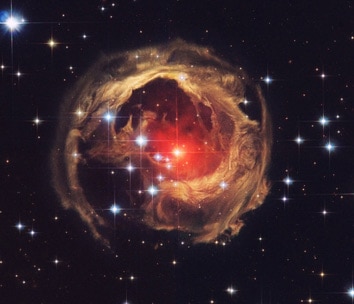Create a free profile to get unlimited access to exclusive videos, sweepstakes, and more!
If You Want to Survive a Black Hole Encounter, Bring a Friend

We think every big galaxy has one at its heart, and the bruiser in the Milky Way’s dead center has a mass 4.3 million times that of the Sun. As you might imagine, the environment around it is a mess. There’s gas and dust everywhere, and quite a few stars circling it.
Some years ago an anomaly was found, an elongated blip of light that looked very much like a small gas cloud orbiting the black hole. It was on a very tight orbit, and an elliptical one. It was predicted that in mid-2014 it would pass a mere 30 billion kilometers or so from the surface of the black hole! That’s close, just a few times the size of our own solar system.
Fireworks were expected as tidal forces from the black hole’s immense gravity would strip gas from the cloud and gobble it down. Many astronomers thought it wouldn’t survive.
But then periapsis—closest approach in astronomy-lingo—came and went … and G2 appeared unfazed. It not only survived the close pass, it seems to have been largely unaffected by it.
Clearly it wasn’t just some cloud of gas. What was it? One idea is that there was a star inside the cloud, and its gravity helped hold it together. The problem is that the size of the object inside the gas cloud would have to be huge, a hundred times bigger than a normal star.
New observations made in the near-infrared part of the spectrum may have finally revealed the identity of the object. First, inside the gas cloud is a smaller cloud of dust, a knot of complex carbon molecules commonly produced when stars are born or when they die. But even that is odd; what could make the dust?
It appears that the answer may be another weird object: a star that was once two stars orbiting each other, but which merged some time ago!
Such mergers do happen but are rare. For example, the bizarre star V838 Monocerotis is the product of a binary merger. When this occurs, a lot of dust can be produced and expelled, which would explain the dust inside G2. A merging binary fits many of the other observed properties of the object, and it turns out that repeated close passes to the black hole can poke a binary system hard enough to make the stars merge. Over time, the resulting object after a merger will look like a hot (B-type) star … and there’s an overabundance of such stars near the black hole. It’s not clear, but it’s possible a lot of those stars were binaries that got close to the block hole, merged, and eventually settled down.
While it’s not completely conclusive, this new study does feel satisfactory, explaining a lot of the properties of a really peculiar object. The next step would be to study the other hot stars around the black hole and see if their orbits take them close enough to the black hole that, if they started off as binaries, would have caused them to merge as well. If so, that would be another plank on which this idea could rest.
I find this story enthralling. What’s not to love? A huge black hole, a dangerously close encounter, and the really weird object that lived through it. And the lesson here, of course, is that if you want to survive getting close to a black hole, bring a friend … and be prepared for them to become a very close friend.














